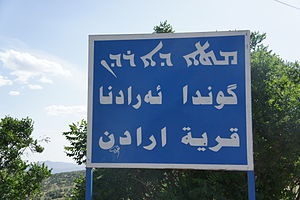| Languages of Iraq | |
|---|---|
 Sign near Araden with text in Neo-Aramaic, Kurdish and Arabic Sign near Araden with text in Neo-Aramaic, Kurdish and Arabic | |
| Official | Arabic and Kurdish |
| Vernacular | Mesopotamian Arabic |
| Minority | Farsi, Turkmen, Northeastern Neo-Aramaic and Classical Syriac, Armenian and Domari |
| Foreign | English |
| Signed | Iraqi Sign Language |
| Keyboard layout | Arabic keyboard |
There are a number of languages spoken in Iraq, but Mesopotamian Arabic (also known as Iraqi Arabic) is by far the most widely spoken in the country.
Contemporary language
The most widely spoken language in Iraq is the Arabic language (specifically Mesopotamian Arabic); the second most spoken language is Kurdish (mainly Sorani and Kurmanji dialects), followed by the Iraqi Turkmen/Turkoman dialect of Turkish, and many Northeastern Neo-Aramaic dialects.
Standard Arabic is written using the Arabic script but Mesopotamian Arabic is written with a modified Perso-Arabic script and so is Kurdish (see Sorani alphabet). In 1997 the Iraqi Turkmen/Turkoman adopted the Turkish alphabet as the formal written language and by 2005 the community leaders decided that the Turkish language would replace traditional Turkmeni (which had used the Arabic script) in Iraqi schools. In addition, the Neo-Aramaic languages use the Syriac script.
Other smaller minority languages include Shabaki and Armenian.
Official languages
Official languages of Iraq are defined by the Constitution of Iraq, that was adopted on September 18, 2005 by the Transitional National Assembly of Iraq. It was confirmed by constitutional referendum, held on October 15, 2005. Official text of the Constitution was published on December 28, 2005 in the Official Gazette of Iraq (No. 4012), in Arabic original, and thus came into force. The official translation (in English, for international use) was produced in cooperation between Iraqi state authorities and the United Nations' Office for Constitutional Support.
According to the Article 4 of the Constitution, Arabic and Kurdish are the official languages of Iraq, while three other languages: Turkish, Neo-Aramaic and Armenian, are recognized as minority languages. In addition, any region or province may declare other languages official if a majority of the population approves in a general referendum.
History
The oldest recorded languages of Iraq were Sumerian language and Akkadian language (including ancient Assyrian and Babylonian). Sumerian was displaced by Akkadian by 1700 BCE, and Akkadian was gradually displaced by Aramaic, from 1200 BCE to 100 CE. Sumerian and Akkadian (including all ancient Assyrian and Babylonian dialects) were written in the cuneiform script from 3300 BCE onwards. The latest positively identified Akkadian text comes from the first century CE.
The language with the longest recorded period of use in Iraq is Aramaic, which has a written tradition dating back for more than 2000 years, and survives today in its descendants, the Neo-Aramaic languages.
References
- Jastrow, Otto O. (2006), "Iraq", in Versteegh, Kees; Eid, Mushira; Elgibali, Alaa; Woidich, Manfred; Zaborski, Andrzej (eds.), Encyclopedia of Arabic Language and Linguistics, vol. 2, Brill Publishers, p. 414, ISBN 978-90-04-14474-3
- "Iraq, CIA World Factbook". CIA. 31 July 2012. Retrieved August 8, 2012.
- Türkmeneli İşbirliği ve Kültür Vakfı. "Declaration of Principles of the (Iraqi?) Turkman Congress". Archived from the original on 2012-03-08. Retrieved 2011-11-25.
- Nissman, David (5 March 1999), "The Iraqi Turkomans: Who They Are and What They Want", Iraq Report, 2 (9), Radio Free Europe/Radio Liberty
- Shanks, Kelsey (2016), Education and Ethno-Politics: Defending Identity in Iraq, Routledge, p. 57, ISBN 978-1-317-52043-6
- Sara B. Moller (2005), Low Intensity Conflict and Nation-Building in Iraq: A Chronology
- Jonathan Morrow (2005): Iraq’s Constitutional Process II: An Opportunity Lost
- Constitution of the Republic of Iraq, Official Gazette of Iraq, No. 4012, of December 28, 2005 (Arabic text)
- UN WIPO: Iraqi Constitution (2005) in English translation
- The ACE Electoral Knowledge Network: Iraqi Constitution (2005)
- Iraq, Ministry of Interior - General Directorate for Nationality: Iraqi Constitution (2005)
- John Gay and Christopher Woods, 2004 "Akkadian and Eblaite", The Cambridge Encyclopedia of the World's Ancient Languages ISBN 0521562562, p. 218.
- Brock 1989, p. 11–23.
- Khan 2007, p. 95–114.
Sources
- Brock, Sebastian P. (1989). "Three Thousand Years of Aramaic Literature". ARAM Periodical. 1 (1): 11–23.
- Khan, Geoffrey (2007). "Aramaic in the Medieval and Modern Periods" (PDF). Languages of Iraq: Ancient and Modern. Cambridge: The British School of Archaeology in Iraq. pp. 95–114.
- Naby, Eden (2004). "From Lingua Franca to Endangered Language: The Legal Aspects of the Preservation of Aramaic in Iraq". On the Margins of Nations: Endangered Languages and Linguistic Rights. Bath: Foundation for Endangered Languages. pp. 197–203. ISBN 9780953824861.
External links
- Constitution of Iraq, from official Iraqi an UN sources, also accepted as Wikisource text
- Iraq, Ministry of Interior - General Directorate for Nationality: Iraqi Constitution (2005)
- UNESCO: Iraqi Constitution (2005)
- UN WIPO: Iraqi Constitution (2005)
- Other links
- "Conversational Code-Switching between Arabic and Kurdish in Duhok City". Idrees Ali Zebari, M.A. Applied Linguistics, Duhok Polytechnic University , Kurdistan, Iraq. International Journal of Science and Research (IJSR).
| Official languages | |
|---|---|
| Official minority languages | |
| Other minority languages | |
| Sign languages | |
| Languages of Asia | |
|---|---|
| Sovereign states |
|
| States with limited recognition | |
| Dependencies and other territories | |